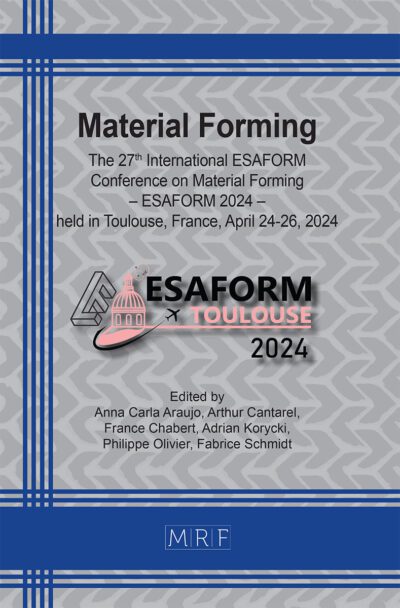Flexible resins lattices produced by stereolithography for biomedical applications
Stefano Belcuore, Stefano Pandini, Elisabetta Ceretti, Paola Ginestra
Abstract. Stereolithography offers a promising solution to produce bespoke structures as surgical guides, models, and implants. The high aspect ratio of the obtained samples combined with different and tailorable mechanical properties make this technique very suitable for 3D-printed medical solutions. However, the epoxy resins used for this technology are toxic and need to be cured and washed very carefully to be used in contact with biological tissues. Most of the time these materials are used for orthoses and external structures instead of implants or tissue engineering scaffolds. Nowadays, lattice structures are achieving specific attention due to the possibility of tailoring the mechanical properties with lightweight geometries that can be 3D printed with several materials. The drawback point is that all the biomedical resins are rigid and show a fragile, although with relatively high maximum stress values, behavior. Moreover, it is even more difficult to fabricate both a flexible and a transparent part, especially by lithography polymerization, and transparent materials are usually required for certain biomedical applications. In this paper, we wanted to obtain a lattice structure that can be suitable for silicon liners as part of knee external prostheses with a flexible biocompatible, and transparent resin.
Keywords
Lattice Structures, Flexible Resin, Stereolithography
Published online 5/7/2025, 10 pages
Copyright © 2025 by the author(s)
Published under license by Materials Research Forum LLC., Millersville PA, USA
Citation: Stefano Belcuore, Stefano Pandini, Elisabetta Ceretti, Paola Ginestra, Flexible resins lattices produced by stereolithography for biomedical applications, Materials Research Proceedings, Vol. 54, pp 12-21, 2025
DOI: https://doi.org/10.21741/9781644903599-2
The article was published as article 2 of the book Material Forming
![]() Content from this work may be used under the terms of the Creative Commons Attribution 3.0 license. Any further distribution of this work must maintain attribution to the author(s) and the title of the work, journal citation and DOI.
Content from this work may be used under the terms of the Creative Commons Attribution 3.0 license. Any further distribution of this work must maintain attribution to the author(s) and the title of the work, journal citation and DOI.
References
[1] Chenxi Lu , Mengting Hsieh , Zhifeng Huang , Chi Zhang , Yaojun Lina, Qiang Shen , Fei Chen ,Lianmeng Zhang. W. (2022). Architectural Design and Additive Manufacturing of Mechanical Metamaterials: A Review. Engineering, 17, 44-63. https://doi.org/10.1016/j.eng.2021.12.023
[2] Shangqin Yuan, Fei Shena, Jiaming Bai, Chee Kai Chua, JunWei, Kun Zhou. 3D soft auxetic lattice structures fabricated by selective laser sintering: TPU powder evaluation and process optimization, W.(2017). Materials and Desing, 120,317-327. http://dx.doi.org/10.1016/j.matdes.2017.01.098
[3] Mussini Andrea, Carter Luke, Villapun Victor, Cao Emily, Cox Sophie, and Ginestra Paola. 3D printing for Growth Adaptive Medical Devices: an alternative approach for craniosynostosis (2024) Procedia CIRP, 125, 319-324. 10.1016/j.procir.2024.08.054
[4] Mussini Andrea, Carter Luke, Villapun Victor, Cao Emily, Cox Sophie, and Ginestra Paola. Experimental and computational analysis of 3D printed 2D lattices (2024) Materials Research Proceedings, 41, 390-397. 10.21741/9781644903131-44
[5] Riva Leonardo, Ginestra Paola Serena, Pandini Stefano and Pasini Chiara. Production and characterization of the Poisson’s ratio of cellular structured metamaterials by additive manufacturing (2022) Procedia CIRP, 110, 380-384. 10.1016/j.procir.2022.06.067
[6] Tsai,Hung-Yin, Ceretti Elisabetta, Rizzi Davide, Ginestra Paola, Kao Tuan-Huan, Leu Ming. Laser-induced metallization on flexible polymer coating: Analysis and application (2021) Journal of Materials Processing Technology, 290, 116986. 10.1016/j.jmatprotec.2020.116986
[7] Riva Leonardo, Mazzoldi Elena Laura, Ginestra Paola Serena, Ceretti Elisabetta and Giliani Silvia Clara. Eye model for floaters’ studies: production of 3D printed scaffolds (2022) Progress in Additive Manufacturing, 7, 1127-1140. 10.1007/s40964-022-00288-5












